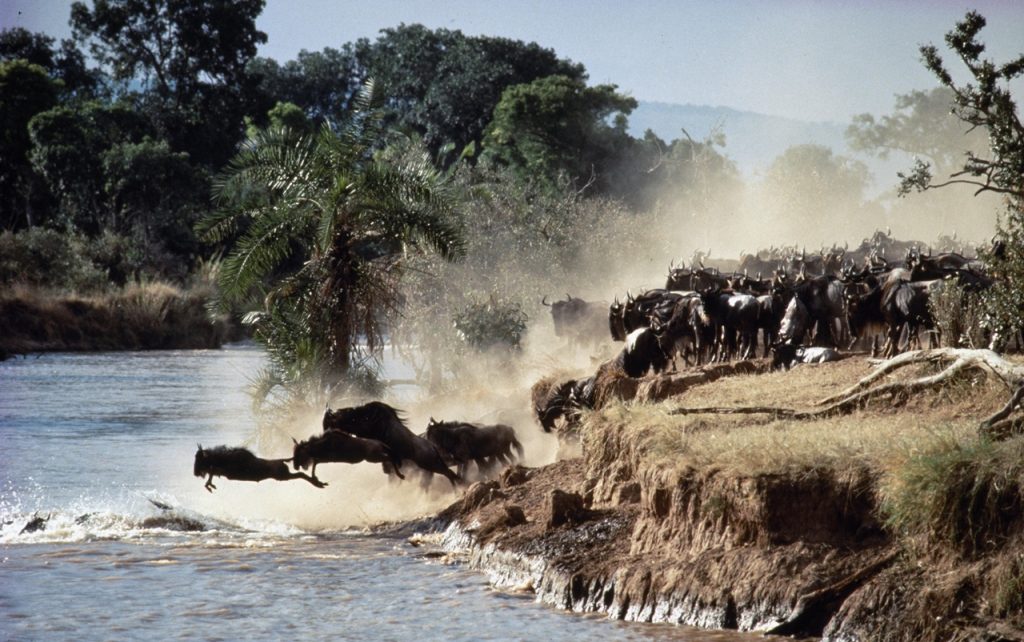Anyone hearing the loud singing coming from Isaac Chereger’s farm would be forgiven for thinking it was a particularly enthusiastic church gathering.
Instead, it was a group of women calling to order a meeting of a local religious charity that teaches villagers how to conserve the forest around their homes in this southwestern Kenya community, to help stop the Mara River from drying.
For more than a decade, environmental groups have raised the alarm over the Mara River, warning that population growth, illegal logging and overuse of its waters by communities struggling through drought have caused a dramatic drop in the river’s water levels.
At the meeting on Chereger’s farm, some villagers volunteered to plant saplings where their fields meet the river, while others agreed to get training on why the unplanned felling of trees along the river could worsen the impact of drought.
Chereger told the Thomson Reuters Foundation he is proud of the conservation work his community does, but has long wondered if it was enough.
That’s why the Empowering Lives International Centre – which put on the meeting on his farm – has joined other local organisations in an effort to give their traditional conservation work some technological muscle.
The pilot scheme run by the Stockholm Environment Institute, an international research organisation, trains villagers to use a water evaluation and planning (WEAP) tool that generates a digital forecast on the health of a water source.
When communities know what to expect from the Mara River’s changing water levels, they can more quickly adapt and find the most effective ways to slow the drying of the river, the institute’s researchers say.
The group in Ilula village say they are keen to add the system to their conservation toolbelt.
“The Mara River gives us pasture and water for our cattle. If this innovation can help in preventing bad use of the river, then we are ready to work with it,” said Chereger.

WADING GOATS
There are currently no official figures on how much water levels in the Mara River basin, home to about a million people, have dropped over the past few decades.
But Nkoinko Siposha, from Oloroito village in the upper basin, recalled that in the 1990s it was impossible for his cattle to wade through any part of the river because of its depth.
These days, even goats walk leisurely through the drying river to graze on the other side of its shores, the 65-year-old herder told the Thomson Reuters Foundation.
Starting in the Mau forests, in southwestern Kenya, the Mara River basin stretches over 13,750 square kilometres (5,300 square miles), through the Maasai Mara National Reserve in Kenya and Tanzania’s Serengeti plains, before it spills into Tanzania’s Lake Victoria.
Tom Ogol, a former researcher at the Stockholm Environment Institute, told the Thomson Reuters Foundation there are several key threats to the river.
They include loss of forests along its shores and unsustainable agricultural activity, such as farmers illegally siphoning water from the river for irrigation.
Both are “aggravating what climate change has already altered”, with increasingly long droughts now a problem, Ogol said.
In October last year, Rift Valley commissioner George Natembeya said the growing number of flower farms cropping up along the river are a problem, with some farmers using petrol-powered pumps to suck water from the river.
Such pumps are restricted in the county due to the pollution they cause.
According to Natembeya, water demand in the Mara River basin is over 20 million cubic metres per year, with irrigated agriculture accounting for about half of that.
“This demand is too much. The river cannot provide it all because its water sources, which are in the basin, are drying up due to climate change,” Natembeya said during a press briefing.
He then delivered a dire prediction.
“The Mara River will be dead in three years,” he warned.
REPORTING VIOLATIONS
Technology has become a vital tool for protecting the river, said Emmanuel Nkurunziza, director-general of the Nairobi-based Regional Centre for Mapping of Resources for Development.
Digital innovations such as the WEAP have made it easier for communities, development organisations and governments to detect changes in the Mara’s water level and quality, and helped them reverse or adapt to those changes, he said.
“Technology enables the tracking of threats to the Mara river over a period of time. With this it is possible to identify whether these threats are caused by human activities or climate change,” Nkurunziza told the Thomson Reuters Foundation.
Ogol described WEAP as a “user-friendly” software tool that collects data on the river’s status provided by communities and government agencies such as the meteorological department.
The system looks at factors such as rainfall and crop requirements for water, he said.
Farmers involved in the project can also use text messaging to report other farmers or corporations who take too much water out of the river or withdraw water without a license.
The system then combines that information with other pressures on the water supply, such as changing weather patterns and population figures, to predict how the river will cope with demand in the future.
“The data can be used to plan and allocate resources that help communities living there to adapt and build resilience” to climate change, Ogol said.
Because the project is still in the pilot phase, Ogol said he does not yet have figures on how many farmers are taking part.
Nkurunziza was confident the system would play an important role in tackling climate change threats.
But, he told the Thomson Reuters Foundation, how much the system will benefit farmers living along the Mara River depends on the decisions local lawmakers make based on the data.
“We might be able to identify what is happening to the Mara River, but the political circumstances surrounding the causes of the problems might determine whether there is action or not,” he said.

